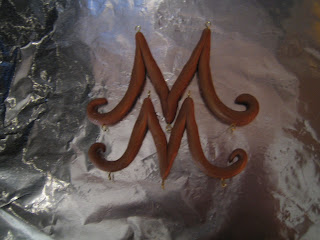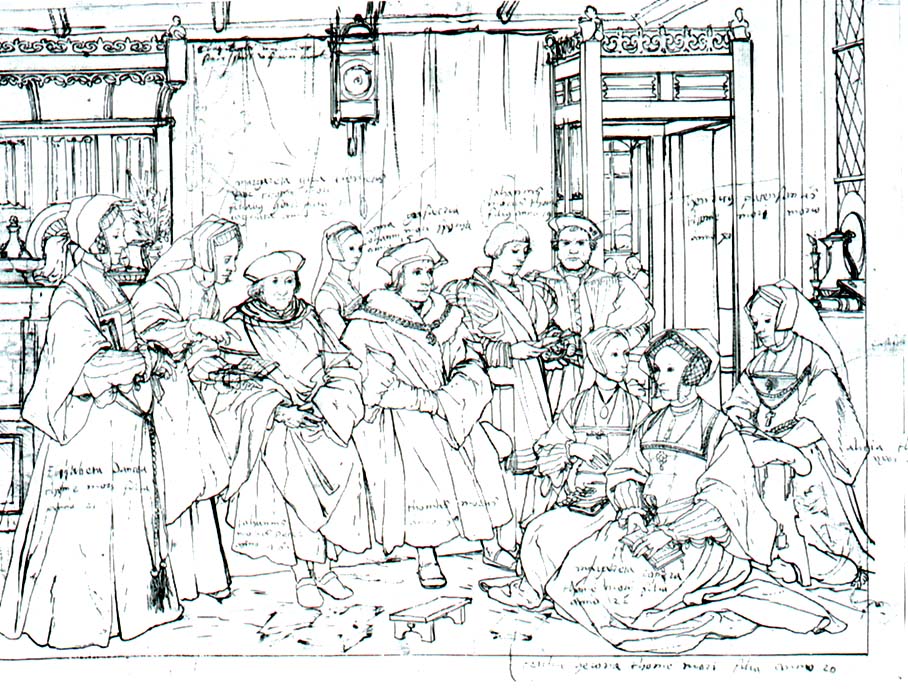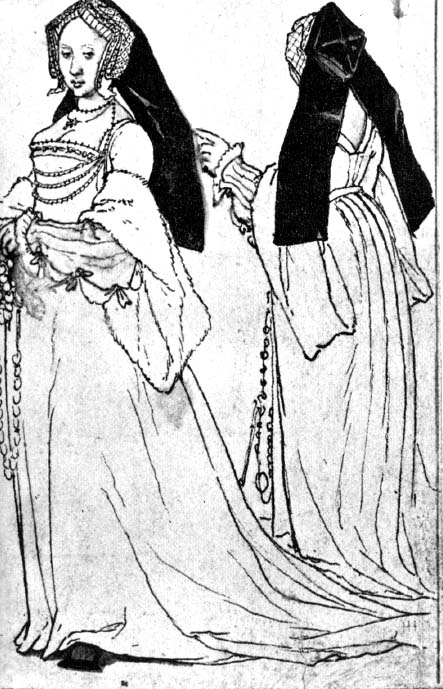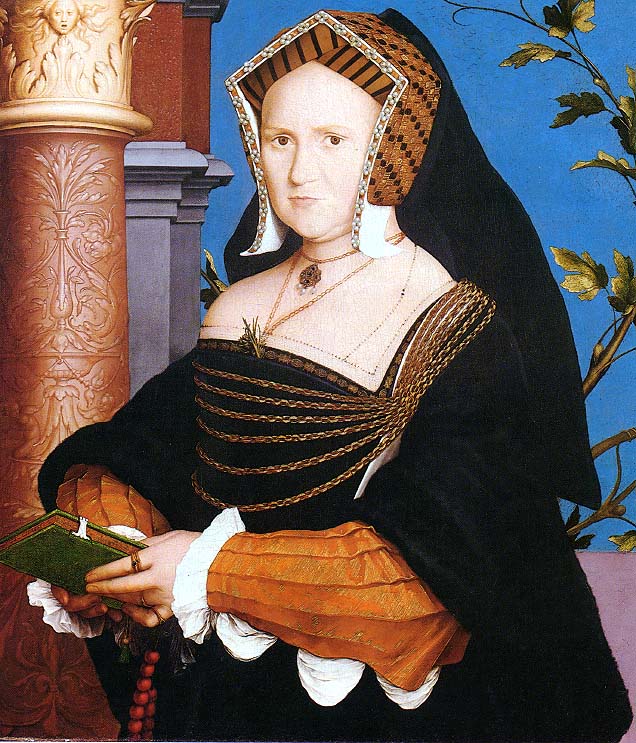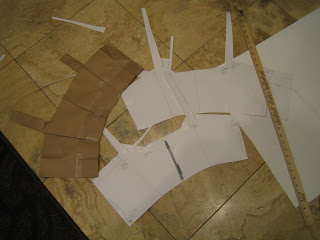When I was approaching my farthingale project, I realized there wasn't a whole lot of information regarding Simplicity's Tudor Underpinning pattern (number 2621). So, I decided I'd be sure to try to take as many photographs as I could remember to, and to share my experiences with it.
For a more involved idea of my vision, please
see my previous post. The short version is that I was really intimidated by the idea of making a farthingale, and so I decided to use Simplicity 2621 as the base for my farthingale, with the size of the hoops dictated by Melissa of
www.sempstress.org's recommendations, based on her research on Alcega's period pattern layout for farthingales. That's a bad sentence. Basically, it is my understanding that I can reproduce the angle of Alcega's farthingale by using hoops of the lengths she has calculated, whether or not the waist and length of the farthingale match his original. There.
The chart is here, if you'd like to have a look; she does a much better job of explaining what this is all about than I do.
You have to understand two things about me for the rest of this to make sense: I am really lazy when it comes to things people won't see (sure, let's just say it's only with those pieces...) but I also obsess unhealthily about the best way to do things, and getting the right silhouette to things. This means I am almost always working at cross-purposes, and this leads to all sorts of bad mix-ups that could be avoided by either adhering to the "quick and dirty" way or the "right" way of doing things, but usually works out in the end.
So, to start with, I found the three pattern pieces that make up the Simplicity pattern; unlike Alcega's farthingale pattern, which includes two front gores and two back gores, you cut four of the same gore in Simplicity's pattern. Ok, I can deal with this. It's a hoop skirt, I don't much care where the seams are (ok yes I do, I like how the Alcega farthingale puts more of the bulk in the back; but I've made my peace with this). As long as the angle is accurate to the Alcega pattern, I figure that will get me close enough. I immediately tossed aside the third pattern piece, which was the one for the waistband. Frankly, patterns for waistbands confuse me, and I always end up winging that part.
I added length to the pattern because when I held the front/back piece up to me, it seemed awfully short; because I ended up adding a bit of length through my waistband method and hemming method, I ended up cutting off all but about one inch of that extra length. For reference, I am not a tall girl; I am just under 5'4", with a waist-to-floor measurement of about 41" (give or take an inch for user error here), and I knew I would need an extra inch or two of length for the flare of the skirt. If you are making up this pattern, I highly recommend measuring and just making sure you have enough length to work with.
As for the sizing, I fell on the border of the 20 and 22 measurements, but chose to cut on the 20 line because (1) I didn't want extra bulk at the waist, and I knew this had plenty of ease to get over my hips and (2) I knew my hoops would be smaller than those called for by the pattern, so I really didn't need all of the width that had been drafted into Simplicity's pattern. The pattern called for four yards of fabric, and that's how much I used. Once again, I looked at the suggested pattern layout, shrugged my shoulders, and then did it my way. What was my way? Well, my synthetic taffeta was 50 inches wide, and so I was able to fit the gores butted up against one another to make a rectangle (the pattern was flipped with the wrong side of the paper up so it would fit this way; it helped that I had fabric that didn't have an obvious right side). I then used a yardstick and tailors chalk to mark my new cutting line that at the hem that would give me some more length, following the curve of the original hem line. The front and back are the same piece, cut on the fold. I folded my fabric in half with the selvage touching (like you usually do when you lay out patterns) to make my fold, then flipped it from cut edge to cut edge so I could cut both the front and the back on the fold at the same time. I know, I told you I was pretty lazy; this worked because my fabric was really thin, and I was very careful in how I folded it.
Then I sewed it up the way the pattern instructed me to. Once again, it was really nice having fabric with an identical "right" and "wrong" side, especially because of my creative cutting layout. I ended up with this:
I know, the front and back are shorter than the gores; this is because when I folded my fabric, I accidentally forgot to leave enough space for all of the extra length I'd originally added. I started cutting at the top and didn't remember to add the length until I got to the bottom. I think I was just too excited from what I thought was a clever way to cut both pieces out at the same time. At any rate, I added as much length as I could and called it good, knowing I'd been REALLY generous with my original addition.
Hey, I never recommended you do things my way; I'm just telling you how I did it.
From here, I stepped into it and eyeballed where I wanted the hem; I was aiming for it to hit my instep. I know, this is risky business, but I was by myself and don't really know anyone in the area who can sew, anyway; I love my boyfriend, but marking hems really isn't his forte. After I figured out how much fabric I needed to remove from the hem in the center front, I measured how much I wanted to keep, and with that number, measured down from the waist all around the skirt, using the pattern pieces to trace the shape of the curve of the hem in tailor's chalk, and then I cut! To be clear, I carefully laid it down just as you see it, with the front and back waist and hem lined up, and then just cut straight across the folded skirt, rather than trying to go around the entire circle. I'm no good at that, and without a helper, that's get tricky. I'll let you know once I finish inserting the hoops if I think this made the hem wonky; I was hoping that by using the curve of the pattern as a guide and measuring from the waist carefully, I'd get the right curve. So far, it looks alright.
I hadn't yet decided what to do about the waistband; I was really tempted to just fold over the top edge twice and do a self-casing for a drawstring, but I thought that would end up looking awful, in addition to taking too much of the length up. Then I thought about sandwiching the fabric between two pieces of ribbon and using the ribbon as the casing, but that would be very bulky. I finally just measured the top edge of the skirt and made a rectangle that long that was 4.5" wide. I ironed each raw edge over twice so no raw edges were showing, did the same on the end, and then folded the entire thing in half and ironed in that crease. To save some time, and because I hate threading drawstrings through casings, I pinned my ribbon drawstring into the waistband, since I knew I would have plenty of room on the bottom of the Finally, I pinned it to the raw edge of the skirt, sandwiching the raw top edge in between the halves of the waistband. Then I sewed! Yes, this left a row of stitches on the front edge. No, it is not the most attractive waistband I have ever in my life seen. But it was fast, easy, and this won't show under my clothing. It looks neat, and that is all I was going for; I just want this to come out looking neat and solidly constructed. Or at least, something approximating that...
 |
| The ribbon pinned into the waistband |
 |
| I just folded the edges so that the raw edges were enclosed |
 |
| Here's the opening; I folded the edges under twice to enclose the raw edge and sewed it in one go, pivoting at the bottom. For all of you who also follow my beauty blog, this is why I always wear nail polish; my poor discolored, wonky nails! |
 |
| Here's where the two halves of the waistband meet up on the inside |
 |
| Another image of the opening at the waistband from the inside; I folded the open edge of the skirt under and sandwiched it like that between the waistband at the top edge. |
 |
| The attached waistband! And yes, the drawstring works... I didn't sew over it! |
I don't have any pictures for the next step, but that was marking the lines for the hoop casings. I got the pattern out again and used it to mark across the front and back of the skirt with tailors chalk. I just kind of scooted the appropriate edge of the appropriate pattern piece across the front and back, making sure to keep the angle from top to bottom align as much as I could to approximate the curve. Looking back, that may have been fruitless; those things kept wanting to sew straight as I put them through the machine. Oh well, I guess I'm glad I tried. The only thing I changed was that I played around with the bottom, adding a hoop between the hem-hoop and the next to the bottom hoop. To do this, I scooted the next-to-the-bottom hoop up two inches, and then put another hoop between that one and the base. I just wanted this thing to be a little sturdier, because I know my skirts are going to be very heavy. I will have six hoops in my farthingale, instead of the five that Simplicity suggests. After these lines were marked in chalk, I pinned the ribbon down, making sure to place the pins in the right direction to take them out as I sewed. I only did a couple of casings at a time, because I didn't want to be wrestling this thing through the machine and getting stabbed by pins from another casing. Each casing is one continuous piece of ribbon that I left open on the side that the drawstring ties on; I actually ran out of ribbon when I got to my last casing, the middle one. That is why there is a big gap between the ribbons in the following photos. I will have ended up using 4 spools of Offray 7/8 inch grosgrain ribbon from JoAnn Fabric; I was able to get all but the middle casing out of three spools.
A tip on pinning the ribbon on; flat things and curves don't get along. Grosgrain ribbon does not like to be sewn to something that is bigger on the bottom edge than on the top edge. I made my peace with making tucks where I had to, and I found that holding my hand under where I was pinning, so that the ribbon and the fabric both stretched over a convex curve, really helped ease the process along. Likewise, as I sewed, I tried to hold the fabric relatively taught with a bit of a downwards bend over the edge of the machine to mimic this convex curve. If that makes any sense. The ribbon still manged to migrate a bit during the process, but it went relatively smoothly. I think there might just be a learning curve (heh, get it? get it?) for making these darn things. At any rate, here are some more photos of this process.
 |
| most of the casings sewn, one pinned; not perfectly straight, but I think this will do. They migrated as I sewed them! |
 |
| The edges I left open |
I used the hemming method advocated on
Sempstress' farthingale tutorial,
the ribbon hem . This hem appealed to me because it is nice and finished, and it forms the casing for your bottom hoop.There is a very good tutorial if you follow the link above, which is what I used, but here are the basics. I put the top edge of the ribbon near the raw edge of the fabric on the wrong side, since I wanted to keep the hem fairly long, so that the better part of the ribbon hung over the edge of the skirt, and I sewed close to the edge of the ribbon.
Here it is sewn down and ironed; I forgot to take a picture when it was just pinned, so I unfolded it to show you what it looks like. For reference, this is the wrong side of the skirt; the ribbon covers the edge of the fabric and hangs over the edge.
After you've sewn it from the wrong side, you iron it over to the right side, so the raw edge of your hem ends up encased by the ribbon. I ironed a bit of the fashion fabric forward because it laid nice and flat this way; the curve of the hem was on the bias and ironed out nicely, and I thought it looked pretty.
Here is the ribbon ironed to the front, before I sewed the top edge down.
Then you just sew the free edge of the ribbon down to your fashion fabric from the right side, right along the edge. I didn't even need to pin it after I ironed it, and it went smoothly. Once again, I left a bit of a gap on the side of the skirt for the hoop to go into.
That's all I've done so far, since I need to get more ribbon and a boning material for the hoops, but I will keep you guys updated on my progress. Expect a more concise summary on my thoughts on the pattern once I finish the farthingale!






